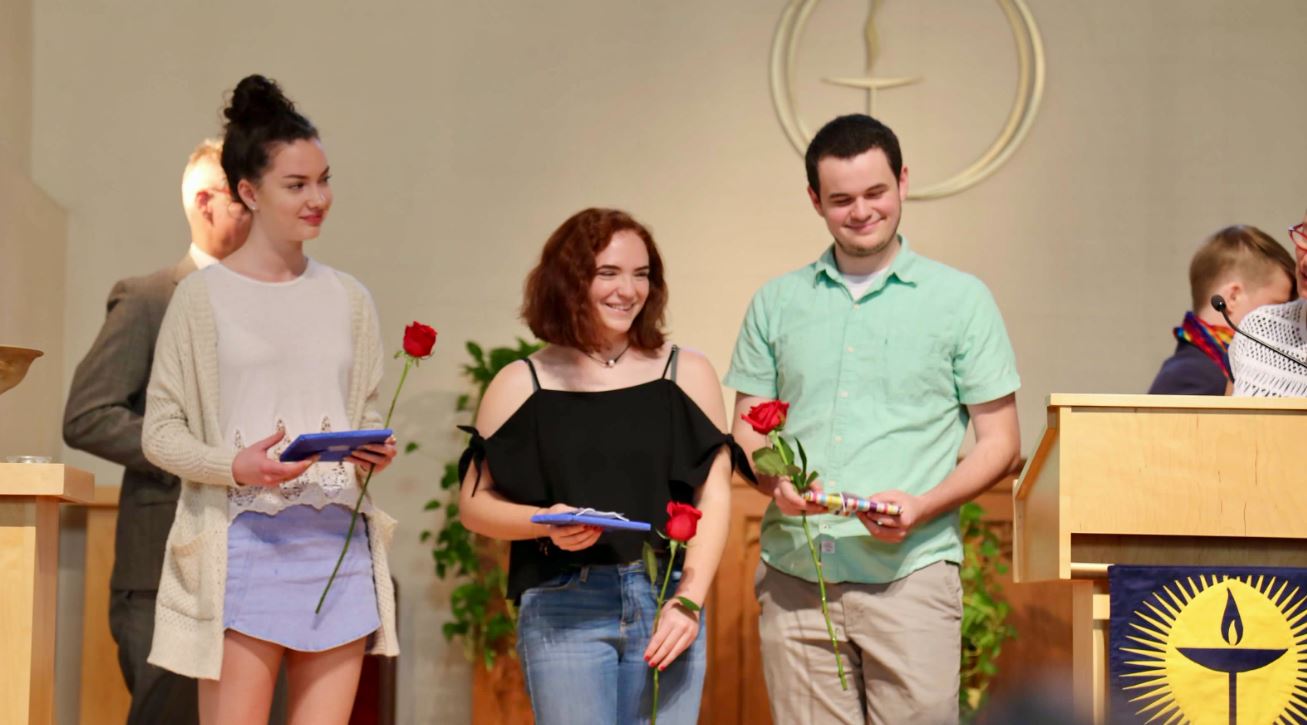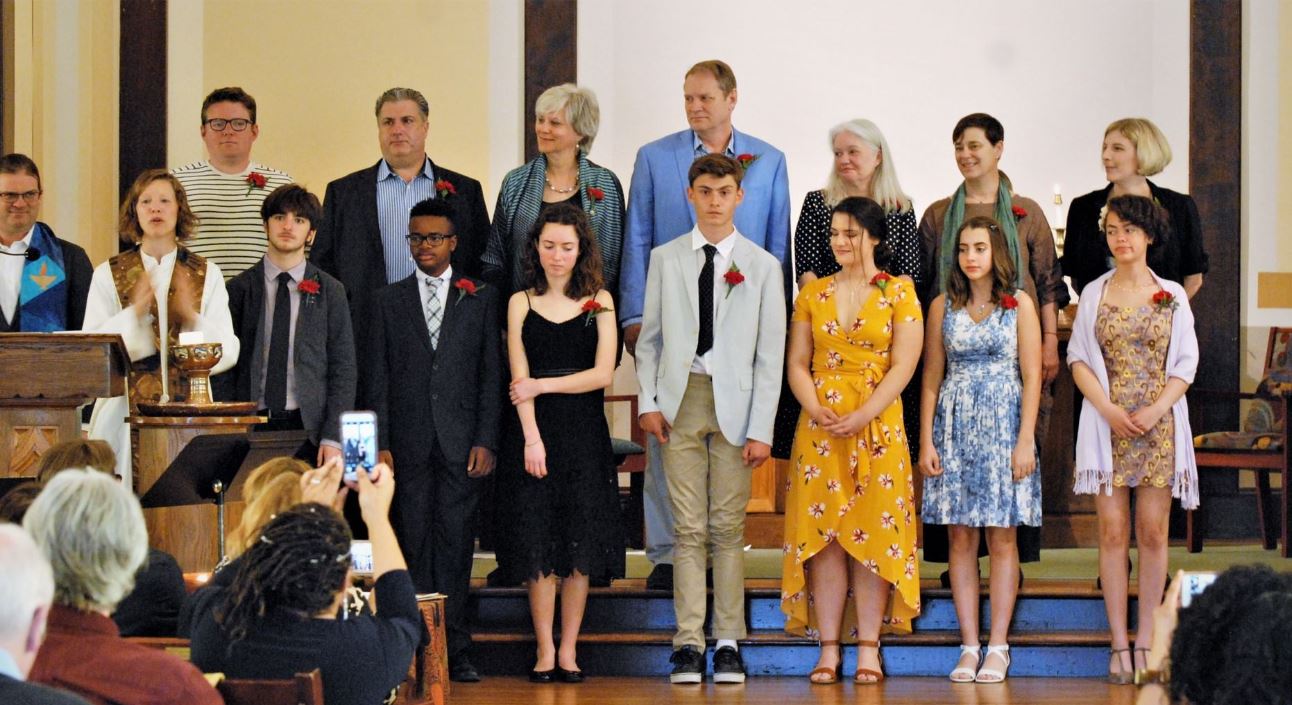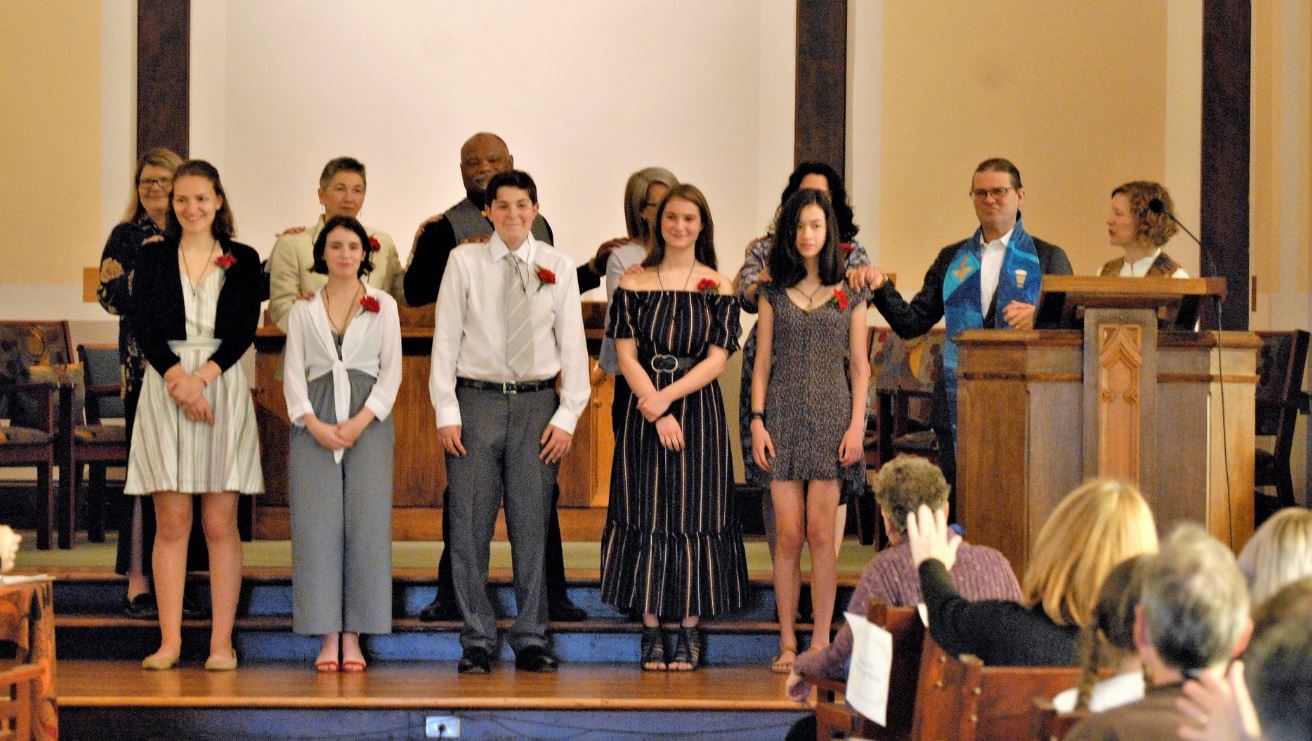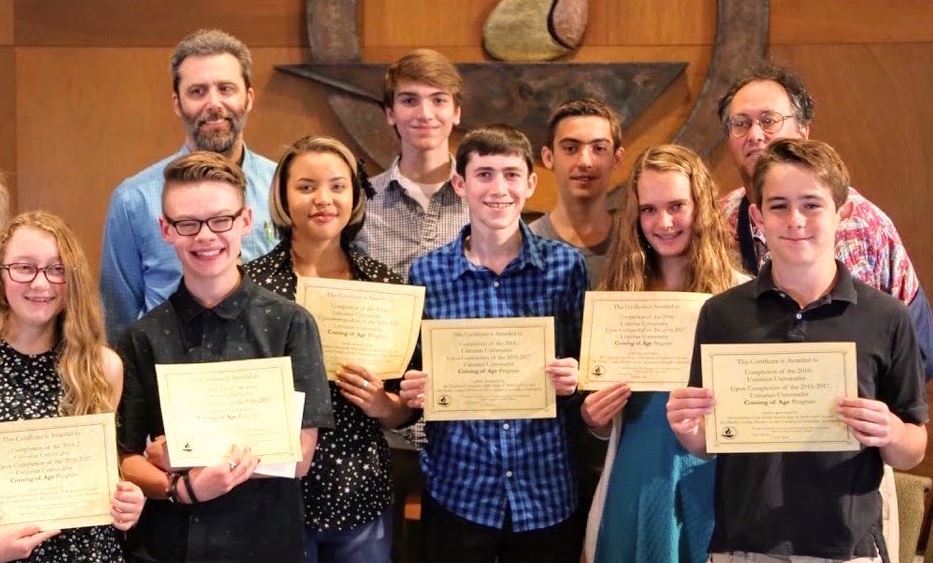Celebrating Coming of Age Uu Chalice Universalism A Journey of Personal Growth and Community Connection
The transition from childhood to adulthood is a significant milestone celebrated in various cultures and religions worldwide. These “coming of age” ceremonies mark the moment when young individuals are recognized as adults within their communities, often accompanied by rituals, traditions, and celebrations unique to each culture. From the Jewish Bar and Bat Mitzvahs to the Latin American Quinceañera, these ceremonies underscore the universal importance of guiding youth through this pivotal life stage.
In this essay, we will delve into the Unitarian Universalist Coming of Age Uu Chalice , a distinctive rite of passage within the Unitarian Universalist (UU) tradition. This ceremony holds profound significance for both the youth who participate and the congregations that support them. We will explore the preparation process, which often includes a year-long curriculum designed to deepen the young participants’ understanding of Unitarian Universalism and help them articulate their personal beliefs. By examining the various elements of the ceremony and its broader implications, we aim to highlight its role in fostering personal growth and strengthening community bonds.
Unitarian Universalism, a liberal religion characterized by a free and responsible search for truth and meaning, offers a unique perspective on spiritual development. Rooted in a rich history of progressive thought, UU congregations emphasize inclusivity, social justice, and individual spiritual journeys. The Coming of Age ceremony is a key component of this tradition, symbolizing a young person’s transition into a more mature spiritual and personal identity. This essay provides an in-depth look at this transformative experience, emphasizing its importance within the Unitarian Universalist community and its lasting impact on the youth who undergo this significant rite of passage.
1. Understanding Unitarian Universalism
1.1. History and Beliefs
Origins and Evolution of Unitarian Universalism
Unitarian Universalism (UU) is a liberal religious tradition that emerged from the consolidation of two separate movements: Unitarianism and Universalism. Both have deep roots in the Protestant Reformation of the 16th century. Unitarianism began in Europe, notably in Poland and Transylvania, emphasizing the oneness of God and rejecting the concept of the Trinity. It gained a foothold in the United States in the late 18th and early 19th centuries, especially in New England, where it attracted many prominent intellectuals and progressive thinkers.
Universalism, on the other hand, was founded on the belief in universal salvation—the idea that a loving God would not condemn anyone to eternal damnation. This movement also took root in the United States around the same time, appealing to rural and working-class communities with its message of hope and inclusion. By the mid-20th century, both Unitarianism and Universalism had grown significantly and began to find common ground in their progressive theological outlooks and commitment to social justice.

In 1961, the American Unitarian Association and the Universalist Church of America merged to form the Unitarian Universalist Association (UUA). This unification was driven by a shared vision of a religion that emphasized personal spiritual growth, social justice, and a free and responsible search for truth and meaning. Today, Unitarian Universalism continues to evolve, embracing a wide range of spiritual beliefs and practices while remaining firmly rooted in its foundational principles.
Core Beliefs and Principles
Unitarian Universalism is not bound by a single creed or dogma. Instead, it is characterized by a set of guiding principles that reflect its commitment to inclusivity, compassion, and justice. The seven principles of Unitarian Universalism are:
- The inherent worth and dignity of every person.
- Justice, equity, and compassion in human relations.
- Acceptance of one another and encouragement to spiritual growth.
- A free and responsible search for truth and meaning.
- The right of conscience and the use of the democratic process.
- The goal of world community with peace, liberty, and justice for all.
- Respect for the interdependent web of all existence of which we are a part.
These principles are supported by a diverse range of sources, including direct experience, prophetic words and deeds, world religions, Jewish and Christian teachings, humanist teachings, and earth-centered traditions. This inclusive approach allows Unitarian Universalism to be a dynamic and evolving faith, welcoming individuals from all walks of life and belief systems.
1.2. Community and Practices
Structure and Function of UU Congregations
Unitarian Universalist congregations are autonomous, self-governing communities that come together under the broader umbrella of the UUA. Each congregation is democratically governed, with members playing an active role in decision-making processes. This democratic structure reflects the UU commitment to the right of conscience and the use of the democratic process within congregations and in society at large.
Congregations vary in size and structure but typically include a minister, religious educators, and various committees and volunteer groups that handle different aspects of congregational life. Regular worship services, usually held on Sundays, are a central aspect of community life, providing a space for reflection, inspiration, and connection. These services often include music, readings, sermons, and opportunities for communal sharing and discussion.
Role of Rituals and Ceremonies in UU Practice
Rituals and ceremonies play a vital role in Unitarian Universalist practice, serving as markers of important life events and spiritual milestones. These include child dedications, weddings, memorial services, and rites of passage such as the Coming of Age ceremony. Unlike in some religious traditions, UU rituals are not bound by strict liturgical forms; instead, they are often personalized to reflect the beliefs and values of the individuals and communities involved.
The flexibility of UU rituals allows them to be deeply meaningful and relevant to participants. For instance, child dedications focus on welcoming new life into the community and committing to support the child’s spiritual growth. Weddings and commitment ceremonies celebrate the union of partners in a way that honors their unique relationship. Memorial services offer a space to mourn and celebrate the life of a deceased loved one, emphasizing the continuing impact of their life on the community.
Overall, the structure and practices of UU congregations underscore the tradition’s commitment to inclusivity, personal growth, and social justice, creating a supportive and dynamic environment for spiritual exploration and community engagement.
2. The Coming of Age Ceremony: An Overview
2.1. Significance and Purpose
Historical Context and Modern Relevance
The Coming of Age ceremony in Unitarian Universalism (UU) is a significant rite of passage that marks the transition from childhood to adolescence. Historically, coming of age ceremonies have been a fundamental part of various cultures and religions, symbolizing the individual’s new status and responsibilities within their community. In the context of Unitarian Universalism, this ceremony has evolved to reflect the denomination’s progressive values and emphasis on personal spiritual growth.

The modern relevance of the Coming of Age ceremony lies in its ability to provide youth with a structured opportunity to explore and articulate their beliefs. In a world where adolescents often face complex social and personal challenges, this ceremony offers a space for introspection, discussion, and affirmation of their emerging identities. It serves as a bridge between childhood and the more nuanced understanding of adulthood, fostering a sense of responsibility and community engagement.
Objectives of the Coming of Age Ceremony
The primary objectives of the Coming of Age ceremony are multifaceted. Firstly, it aims to affirm the individuality and inherent worth of each participant. Unitarian Universalism emphasizes the importance of personal belief and the free search for truth, and the ceremony is a testament to this principle. By encouraging youth to articulate their beliefs, the ceremony promotes self-awareness and confidence.
Secondly, the ceremony seeks to strengthen the bond between the youth and their congregation. It is a communal event where the entire congregation acknowledges and celebrates the growth of its younger members. This public affirmation helps youth feel valued and supported by their community, reinforcing their sense of belonging.
Thirdly, the ceremony provides a formal setting for youth to commit to the values and principles of Unitarian Universalism. Through the preparation process and the ceremonial activities, participants deepen their understanding of UU principles such as justice, equity, compassion, and respect for the interdependent web of existence. This commitment is not just a personal declaration but also a pledge to uphold these values in their interactions with the wider world.
2.2. Timing and Occurrence
Typical Timing (Late Spring) and Seasonal Significance
The Coming of Age ceremony typically takes place in late spring. This timing is significant for several reasons. Spring is traditionally a season of renewal and growth, mirroring the personal development and new beginnings symbolized by the ceremony. The natural environment during spring, with its blossoming flowers and warming temperatures, serves as a fitting backdrop for a celebration of youth and the promise of the future.
Moreover, holding the ceremony in late spring aligns with the academic calendar. It often coincides with the end of the school year, a time when students are already transitioning to new stages in their educational journeys. This timing allows for a seamless integration of the ceremonial milestone with other significant changes in the lives of the participants, reinforcing the theme of transition and growth.
Reasons for Choosing This Period
Choosing late spring for the Coming of Age ceremony is also practical. It allows for a year-long preparation process, starting in the previous fall, which gives ample time for participants to engage deeply with the curriculum and develop their credo statements. The extended preparation period ensures that youth are not only ready for the ceremony itself but have also had the opportunity to reflect meaningfully on their beliefs and values.
Additionally, this period is often less busy than the winter holiday season or the start of the school year, making it easier for families and congregations to focus on the ceremony without competing commitments. The relatively calm period of late spring allows for a more thoughtful and less hurried celebration, giving the event the attention and reverence it deserves.
In summary, the Coming of Age ceremony’s timing in late spring is both symbolically and practically significant, enhancing its impact and ensuring that it is a meaningful and memorable experience for all involved. This thoughtful scheduling underscores the ceremony’s role in fostering personal growth and community connection, hallmarks of the Unitarian Universalist tradition.
3. The Preparation Process
3.1. Year-Long Curriculum
Overview of the Curriculum and Its Goals
The preparation process for the Coming of Age ceremony in Unitarian Universalism is comprehensive and thoughtfully designed. It typically spans a full year, allowing ample time for participants to delve deeply into their spiritual journeys and develop a mature understanding of their beliefs. The primary goal of the curriculum is to facilitate personal growth, foster a sense of community, and help youth articulate their beliefs in a coherent and meaningful way.

The curriculum aims to equip participants with the knowledge and tools they need to explore their identities, beliefs, and values within the framework of Unitarian Universalism. It also encourages them to engage with the broader UU community, fostering a sense of belonging and mutual support.
Key Components of the Curriculum
The year-long curriculum is structured around several key components:
- Religious Education: This involves studying the history, principles, and values of Unitarian Universalism. Participants learn about the origins of the movement, its evolution, and its core tenets, such as the emphasis on social justice, inclusivity, and the free and responsible search for truth.
- Personal Reflection: Youth are encouraged to engage in regular reflection on their personal experiences, beliefs, and values. This component is crucial for helping them develop self-awareness and a deeper understanding of their spiritual journeys.
- Community Service: A significant aspect of the curriculum is participating in community service projects. These projects help youth put their UU principles into action, fostering a sense of responsibility and connection to their local communities.
- Mentorship: Each participant is paired with a mentor from the congregation. Mentors provide guidance, support, and a sounding board for the youth as they navigate their spiritual and personal development.
3.2. Learning About Unitarian Universalism
Educational Activities and Discussions
Educational activities and discussions form the backbone of the Coming of Age curriculum. These activities are designed to be interactive and engaging, helping participants connect with UU principles on a personal level. Common activities include:
- Workshops and Seminars: These sessions cover a range of topics, from UU history and theology to contemporary social issues. Facilitated by religious educators and guest speakers, these workshops encourage critical thinking and open dialogue.
- Discussion Groups: Regular discussion groups provide a forum for participants to share their thoughts, questions, and insights. These groups foster a sense of community and mutual support, as youth learn from each other’s experiences and perspectives.
- Field Trips: Visits to other UU congregations, historical sites, and social justice organizations offer practical insights into how UU principles are applied in different contexts. These experiences broaden participants’ understanding of the UU movement and its impact.
Exploring UU History, Principles, and Beliefs
An essential part of the curriculum is a deep dive into the history, principles, and beliefs of Unitarian Universalism. This exploration helps participants understand the foundational values of their faith and how these values have shaped the UU tradition. Key topics include:
- Historical Development: Participants learn about the origins of Unitarianism and Universalism, the merger of the two movements, and the development of the UUA. This historical context helps them appreciate the rich heritage of their faith.
- Principles and Sources: The curriculum emphasizes the seven principles of Unitarian Universalism and the six sources of inspiration. Youth explore how these principles and sources guide UU beliefs and practices.
- Contemporary Issues: Discussions on contemporary social and ethical issues help participants see the relevance of UU principles in today’s world. Topics might include environmental justice, LGBTQ+ rights, racial equality, and more.
3.3. Personal Belief Articulation
Guidance on Developing Credo Statements
A central aspect of the Coming of Age preparation is the development of personal credo statements. These statements are declarations of the youth’s beliefs, values, and commitments. The process of crafting a credo statement is deeply reflective and often transformative, helping participants clarify and articulate their spiritual and ethical perspectives.
Religious educators and mentors provide guidance throughout this process. They encourage youth to reflect on their experiences, question their assumptions, and express their beliefs authentically. Workshops on writing and public speaking help participants feel confident in sharing their credo statements with the congregation.
Support Systems (Mentors, Educators, Peers)
Support systems are integral to the preparation process. Mentors play a crucial role, offering personalized guidance and support. They build strong, trusting relationships with the youth, providing a safe space for discussing doubts, fears, and aspirations.
Educators facilitate the curriculum, leading workshops, discussions, and activities. They create an inclusive and engaging learning environment, ensuring that each participant feels valued and supported.
Peers also provide essential support. The shared experience of preparing for the Coming of Age ceremony fosters strong bonds among participants. Peer support groups offer encouragement, feedback, and a sense of solidarity, making the journey a collaborative and enriching experience.
Through this comprehensive preparation process, Unitarian Universalist youth are equipped to embrace their coming of age with confidence, clarity, and a deep sense of connection to their faith and community.
4. The Ceremony
4.1. Structure of the Ceremony
Typical Elements and Sequence
The Coming of Age ceremony in Unitarian Universalism is a well-structured event designed to celebrate the transition of youth into a deeper level of spiritual maturity and community involvement. Although the exact format can vary from one congregation to another, most ceremonies include several common elements:

- Opening Words and Welcome: The ceremony typically begins with opening words from the minister or a lay leader, welcoming the congregation and setting a reflective tone for the event.
- Invocation or Chalice Lighting: A central ritual in UU services, the lighting of the chalice symbolizes the light of truth, the warmth of love, and the energy of community. This act often includes a brief invocation or a reading to invite spiritual presence.
- Readings and Music: The ceremony features readings from sacred texts, UU principles, or inspirational literature, interspersed with music performed by the congregation’s choir or musicians. These elements enrich the ceremony and create a contemplative atmosphere.
- Presentation of Youth: The participants are formally introduced to the congregation. This presentation may include brief biographies or personal anecdotes shared by mentors or family members.
- Credo Statements: Each youth reads their credo statement, a personal declaration of their beliefs and values. This is often the highlight of the ceremony.
- Blessing and Gifts: The youth receive blessings from the minister, mentors, or congregation members, along with symbolic gifts that represent their journey and achievements.
- Closing Words and Benediction: The ceremony concludes with closing words that emphasize the ongoing support of the congregation and the continued journey of the youth. A final benediction offers words of encouragement and hope for the future.
Role of the Youth and the Congregation
The youth are the central figures of the Coming of Age ceremony. Their active participation, particularly in the reading of credo statements, is a testament to their personal growth and readiness to take on greater spiritual and community responsibilities. The congregation plays a supportive role, affirming the youth’s journey and pledging ongoing support.
Mentors and family members also play significant roles, providing guidance and encouragement throughout the preparation process and during the ceremony. Their involvement highlights the communal nature of the rite of passage, emphasizing that the youth’s growth is a shared achievement.
4.2. Reading Credo Statements
Importance of Credo Statements
Credo statements are a pivotal part of the Coming of Age ceremony. They are personal declarations where youth articulate their beliefs, values, and aspirations. This process of crafting and presenting a credo statement is both a reflective exercise and a public affirmation of the youth’s emerging identity.
The importance of credo statements lies in their ability to empower youth to define their spiritual paths in their own words. This act of self-expression fosters confidence, clarity, and a sense of ownership over their beliefs. It also serves as a meaningful connection between the individual and the broader UU community, which values diverse perspectives and personal truth.
Examples of Themes and Messages in Credo Statements
Credo statements often reflect a wide range of themes and messages, indicative of the diverse and inclusive nature of Unitarian Universalism. Common themes include:
- Personal Growth and Identity: Reflections on personal experiences, challenges, and milestones that have shaped the youth’s identity.
- Spiritual Beliefs: Articulations of what the youth believes about the nature of spirituality, God, or the universe.
- Ethical Values: Statements about the values that guide their actions, such as justice, compassion, equality, and respect for others.
- Commitments: Declarations of intent to contribute positively to their community and the world, reflecting UU principles of social justice and service.
4.3. Rituals and Symbolism
Common Rituals and Their Meanings
Rituals play a vital role in the Coming of Age ceremony, adding layers of meaning and tradition. Common rituals include:
- Chalice Lighting: As previously mentioned, this symbolizes the light of truth, the warmth of community, and the quest for justice.
- Blessing of Youth: The minister or mentors offer blessings, often laying hands on the youth or offering words of encouragement and hope. This ritual signifies the community’s support and the youth’s readiness to embrace their new role.
Symbolic Actions and Objects Used in the Ceremony
Several symbolic actions and objects are used to enhance the ceremony’s significance:
- Gift of a Chalice: Many congregations present each youth with a small chalice, symbolizing their individual light and connection to the UU community.
- Certificates or Medallions: These items serve as tangible reminders of the youth’s achievements and their commitment to their spiritual journey.
- Ritual of Passage: Some ceremonies include a symbolic act of passage, such as walking through an archway or crossing a threshold, representing the transition from one stage of life to another.
These rituals and symbols deepen the ceremony’s impact, creating lasting memories and reinforcing the values and principles of Unitarian Universalism. Through these meaningful practices, the Coming of Age ceremony becomes a powerful rite of passage that honors the journey of each youth and their integral place within the UU community.
5. Resources and Support for Congregations
5.1. The Coming of Age Handbook for Congregations
Overview of the Handbook by Sarah Gibb Millspaugh
The “Coming of Age Handbook for Congregations,” authored by Sarah Gibb Millspaugh, is an invaluable resource for Unitarian Universalist congregations preparing youth for their Coming of Age ceremony. This comprehensive guide provides a structured framework and practical tools to support religious educators, mentors, and congregational leaders in guiding young individuals through this significant spiritual journey.

The handbook is designed to be user-friendly and adaptable, offering a variety of activities, lesson plans, and reflective exercises tailored to different congregational needs. It aims to facilitate a deep and meaningful preparation process that engages youth in exploring their beliefs, values, and identities within the context of Unitarian Universalism.
Key Tools and Resources Provided in the Handbook
The handbook is rich with resources that cover every aspect of the Coming of Age preparation process:
- Lesson Plans and Activities: Detailed lesson plans provide a roadmap for the year-long curriculum, including interactive activities that encourage youth to engage with UU principles and explore their personal beliefs. These activities are designed to be both educational and enjoyable, fostering a positive and supportive learning environment.
- Reflective Exercises: A variety of reflective exercises help youth delve deeper into their spiritual journeys. These exercises encourage introspection and critical thinking, allowing participants to articulate their beliefs and values more clearly.
- Discussion Guides: Facilitators are provided with discussion guides to lead meaningful conversations about faith, ethics, and personal growth. These guides include prompts and questions that help youth express their thoughts and learn from one another.
- Mentorship Guidelines: The handbook offers detailed guidelines for establishing and maintaining effective mentorship relationships. It emphasizes the importance of matching youth with mentors who can provide guidance, support, and a positive role model.
- Ceremony Planning: Practical advice on planning and conducting the Coming of Age ceremony ensures that congregations can create a memorable and impactful event. This includes tips on incorporating meaningful rituals, organizing logistics, and engaging the wider congregation in the celebration.
5.2. Role of Religious Educators
Responsibilities of Religious Educators in the Preparation Process
Religious educators play a pivotal role in the Coming of Age preparation process. Their responsibilities include:
- Curriculum Implementation: Religious educators are responsible for delivering the year-long curriculum, ensuring that it is engaging, comprehensive, and aligned with UU principles. This involves planning lessons, facilitating activities, and adapting materials to meet the needs of the youth.
- Facilitating Reflection: Educators guide youth through reflective exercises, helping them to explore their beliefs and articulate their personal credo statements. This requires creating a safe and supportive environment where youth feel comfortable sharing their thoughts and experiences.
- Supporting Mentorship: Educators help establish and nurture mentorship relationships, providing mentors with the tools and resources they need to support the youth effectively. This includes training mentors, monitoring their progress, and offering guidance as needed.
- Engaging Families: Religious educators work closely with the families of participants, keeping them informed and involved in the preparation process. This ensures that families can support their children’s spiritual journeys and participate in the Coming of Age ceremony.
Best Practices and Challenges
Religious educators face several challenges in the Coming of Age preparation process, but there are also best practices that can enhance their effectiveness:
- Building Trust: Establishing a trusting relationship with youth is crucial. Educators should create a welcoming and inclusive environment where participants feel valued and respected.
- Balancing Structure and Flexibility: While the curriculum provides a structured framework, it is important for educators to remain flexible and responsive to the needs and interests of the youth. This may involve adapting lessons or activities to better engage participants.
- Encouraging Participation: Active participation is key to a successful preparation process. Educators should use diverse teaching methods, including interactive activities, discussions, and creative projects, to keep youth engaged and motivated.
- Addressing Diverse Beliefs: Unitarian Universalism embraces a wide range of beliefs, and educators must be prepared to facilitate discussions that respect and honor this diversity. Encouraging open dialogue and critical thinking helps youth appreciate different perspectives and develop their own informed beliefs.
- Ongoing Support: Providing continuous support and feedback to both youth and mentors is essential. Regular check-ins, progress assessments, and opportunities for additional guidance ensure that participants remain on track and feel supported throughout their journey.
By leveraging the resources provided in the “Coming of Age Handbook for Congregations” and implementing best practices, religious educators can effectively guide youth through their Coming of Age preparation, helping them to achieve personal growth and a deeper connection to their Unitarian Universalist community.
6. Impact on Youth and Congregations
6.1. Personal Growth and Development
How the Ceremony Fosters Personal Growth and Maturity
The Coming of Age ceremony in Unitarian Universalism is designed to be a transformative experience that fosters personal growth and maturity in youth. Throughout the year-long preparation process, participants engage in deep self-reflection, learn about their faith, and articulate their beliefs, which promotes self-awareness and confidence. The ceremony itself, where they present their credo statements, marks a significant milestone in their journey towards adulthood.

By encouraging youth to explore and express their beliefs, the ceremony helps them develop a clearer sense of identity and purpose. The structured reflection and mentorship involved in the preparation process also teach important life skills such as critical thinking, public speaking, and emotional intelligence. These skills are invaluable as they transition into adulthood, equipping them to navigate life’s challenges with greater resilience and self-assurance.
Testimonials and Stories from Participants
Many participants of the Coming of Age ceremony have shared testimonials and stories that highlight the profound impact of the experience on their personal development. For instance, one participant noted, “The Coming of Age program helped me understand who I am and what I believe in. It gave me the confidence to stand up for my values and speak my truth.” Another youth expressed, “The support from my mentor and the congregation made me feel valued and respected. It was empowering to know that my community believed in me.”
These stories underscore the transformative power of the Coming of Age ceremony, illustrating how it fosters personal growth, strengthens self-confidence, and reinforces a sense of belonging within the UU community.
6.2. Strengthening Community Bonds
Impact on the Congregation’s Sense of Community
The Coming of Age ceremony is not only a significant event for the youth but also for the entire congregation. It serves as a powerful reminder of the congregation’s role in nurturing and supporting the spiritual development of its younger members. The ceremony provides an opportunity for the congregation to come together, celebrate the achievements of the youth, and reaffirm their commitment to fostering a supportive and inclusive community.
The collective participation in the ceremony, from the mentors to the congregation members who attend and celebrate, strengthens the sense of community. It highlights the interconnectedness of all members, emphasizing the communal nature of spiritual growth and the shared responsibility of supporting one another.
Intergenerational Connections and Support
One of the most notable aspects of the Coming of Age program is the fostering of intergenerational connections. Mentorship pairs youth with experienced congregation members, creating meaningful relationships that bridge generational gaps. These connections provide youth with role models and a broader perspective on their spiritual journey, while mentors gain a renewed sense of purpose and connection to the community.
These intergenerational bonds extend beyond the ceremony, contributing to a more cohesive and supportive congregation. They create a network of relationships that enhance the overall sense of belonging and mutual support within the community.
6.3. Long-Term Influence
Influence on Youth’s Future Engagement with Unitarian Universalism
The Coming of Age ceremony has a lasting impact on the youth’s engagement with Unitarian Universalism. By providing a structured and meaningful exploration of their beliefs, the program helps youth develop a strong, personal connection to their faith. This connection often translates into sustained involvement in UU activities and a lifelong commitment to UU principles.
Youth who go through the Coming of Age ceremony are more likely to continue participating in congregational life, whether through youth groups, social justice initiatives, or leadership roles. The sense of accomplishment and recognition they receive during the ceremony reinforces their identity as active and valued members of the UU community.
Broader Implications for Spiritual and Personal Identity
The broader implications of the Coming of Age ceremony extend beyond the immediate UU community. The skills, confidence, and sense of purpose that youth gain from the experience have a ripple effect on their broader lives. They are better equipped to engage with the world around them, advocate for their beliefs, and contribute positively to society.
The personal growth and development fostered by the Coming of Age ceremony also have a lasting impact on the youth’s spiritual and personal identity. The process of articulating and publicly affirming their beliefs helps them establish a strong foundation for their future spiritual journey. It encourages ongoing exploration and growth, ensuring that their identity and values continue to evolve in alignment with the principles of Unitarian Universalism.
In conclusion, the Coming of Age ceremony has a profound and lasting impact on both the youth and the congregation. It fosters personal growth, strengthens community bonds, and influences the long-term spiritual and personal identity of the participants, creating a vibrant and supportive UU community.
7. Unitarian Universalist Perspectives and Insights
7.1. Reflections from UU World Articles
Key Insights from Articles on Coming of Age in the UU World Magazine
UU World magazine, a publication dedicated to exploring the diverse experiences and insights of Unitarian Universalists, has featured numerous articles on the Coming of Age ceremony. These articles provide valuable perspectives on the significance and impact of the ceremony within the UU community. One key insight is the affirmation of the ceremony’s role in fostering personal and spiritual growth among youth. Authors and contributors often highlight how the ceremony encourages introspection, critical thinking, and a deeper understanding of UU principles.
Another important theme is the communal aspect of the Coming of Age ceremony. Articles frequently emphasize how the ceremony strengthens the bonds between youth and their congregations, fostering a sense of belonging and mutual support. This communal connection is seen as essential for the spiritual and personal development of the participants, providing them with a supportive network as they navigate the complexities of adolescence.
Additionally, UU World articles often discuss the evolving nature of the ceremony. Contributors share diverse approaches to the curriculum and ceremony, reflecting the flexibility and adaptability of UU practices. These varied perspectives demonstrate how different congregations tailor the Coming of Age experience to meet the unique needs and contexts of their youth, enriching the overall UU tradition.
Diverse Perspectives Within the UU Community
The diversity within the Unitarian Universalist community is a hallmark of the tradition, and this diversity is reflected in the perspectives shared in UU World articles. Contributors come from various backgrounds, each bringing unique insights and experiences to the discussion of the Coming of Age ceremony. Some articles highlight the experiences of youth from different cultural, racial, and socioeconomic backgrounds, illustrating how the ceremony can be adapted to resonate with a wide range of participants.
These diverse perspectives also extend to the mentors and religious educators involved in the preparation process. Articles often feature interviews and stories from mentors who share their experiences and the profound impact of guiding youth through their spiritual journeys. This diversity of voices enriches the conversation around the Coming of Age ceremony, showcasing the inclusive and multifaceted nature of Unitarian Universalism.
7.2. InSpirit: The UU Book and Gift Shop
Role of UU Book and Gift Shop in Providing Resources
InSpirit, the UU Book and Gift Shop, plays a crucial role in supporting the Coming of Age process by providing a wide array of resources for congregations, educators, and youth. The shop offers books, curricula, and various materials that facilitate the preparation and execution of the Coming of Age ceremony. These resources are carefully curated to align with UU principles and to support the spiritual growth and development of youth.
InSpirit also provides guidance on best practices for religious educators and mentors, offering practical advice and tools to enhance the effectiveness of the preparation process. By supplying these resources, the UU Book and Gift Shop ensures that congregations have access to the knowledge and materials needed to create meaningful and impactful Coming of Age experiences.
Notable Publications and Products Related to Coming of Age
Several notable publications and products available through InSpirit specifically cater to the Coming of Age ceremony. The “Coming of Age Handbook for Congregations” by Sarah Gibb Millspaugh is a cornerstone resource, offering comprehensive guidance on developing and implementing the Coming of Age curriculum. This handbook includes lesson plans, reflective exercises, and ceremony planning tips, making it an invaluable tool for religious educators.
Other significant publications include collections of reflections and testimonials from past participants, which provide inspiration and insight for current and future Coming of Age cohorts. These books often feature diverse voices and experiences, illustrating the wide-ranging impact of the ceremony on individual lives and the UU community as a whole.
In addition to books, InSpirit offers symbolic items such as chalices, medallions, and certificates that can be used during the ceremony. These items serve as tangible reminders of the youth’s journey and accomplishments, enhancing the significance of the rite of passage.
By offering these resources, InSpirit supports the ongoing tradition of the Coming of Age ceremony, ensuring that each new generation of Unitarian Universalist youth can engage in a deeply meaningful and transformative experience. The role of the UU Book and Gift Shop is integral to maintaining the vibrancy and relevance of this important UU tradition.
In this essay, we have explored the Coming of Age Uu Chalice , examining its structure, significance, and impact. We began by understanding the history and core beliefs of Unitarian Universalism, highlighting the tradition’s commitment to inclusivity, social justice, and personal spiritual growth. We then delved into the structure and purpose of the Coming of Age ceremony, emphasizing its role in fostering personal development and community bonds. The year-long preparation process, with its comprehensive curriculum and mentorship, equips youth with the knowledge and confidence to articulate their beliefs through credo statements, which they present during the ceremony.
We also discussed the various resources available to congregations, such as the “Coming of Age Handbook for Congregations” by Sarah Gibb Millspaugh, and the role of religious educators and mentors in guiding youth through this transformative journey. Reflections from UU World articles and resources from InSpirit, the UU Book and Gift Shop, further illustrate the diverse perspectives and support available within the UU community.
The Coming of Age ceremony holds enduring importance in Unitarian Universalism, serving as a pivotal rite of passage that marks the transition from childhood to adolescence. It not only empowers youth to explore and express their beliefs but also strengthens the intergenerational connections within congregations. This ceremony reflects the UU principles of personal growth, community support, and the free and responsible search for truth and meaning.
In closing, the broader implications of the Coming of Age ceremony extend beyond the individual to the entire UU community. It fosters a sense of belonging and mutual support, reinforcing the values that underpin Unitarian Universalism. By nurturing the spiritual and personal development of youth, the Coming of Age ceremony ensures that the UU tradition remains vibrant and relevant, preparing the next generation to contribute meaningfully to their communities and the world at large.
Age -